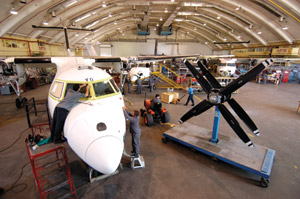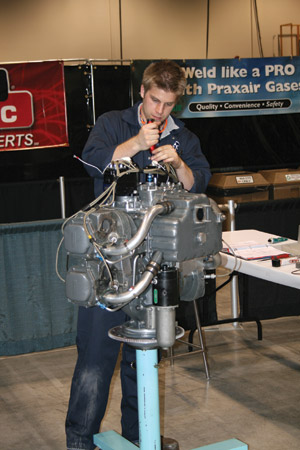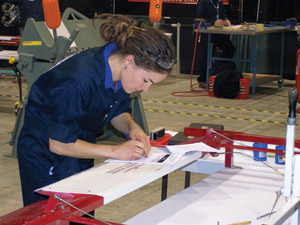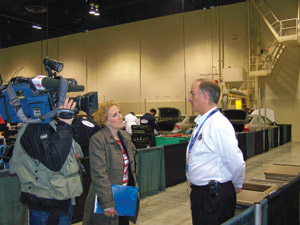
Features
MRO
Keeping up maintenance standards
From the single-passenger, wood-and-steel tube flying machine known as the Silver Dart of the Aerial Experiment Association (AEA) to the 88-passenger CRJ-900 Regional Jet made by Bombardier Aerospace, building and maintaining aircraft have been a part of Canadian history for the past 100 years.
October 8, 2008 By Blair Watson
CAMC supports professionalism in Canada
From the single-passenger, wood-and-steel tube flying machine known as the Silver Dart of the Aerial Experiment Association (AEA) to the 88-passenger CRJ-900 Regional Jet made by Bombardier Aerospace, building and maintaining aircraft have been a part of Canadian history for the past 100 years. In 1908, the AEA had five members; today, there are more than 146,000 people employed in aircraft construction and maintenance in Canada. Canadian aerospace has annual revenues totalling $24 billion, and only three countries produce more: the U.S., U.K. and France.

Today, there are more than 146,000 people employed in aircraft construction and maintenance in Canada.
(Photo courtesy of Voyageur) |
Representing and assisting aviation and aerospace companies is the Canadian Aviation Maintenance Council (CAMC), a not-for-profit sector organization that, in conjunction with industry members, develops and publishes national occupational standards (with supporting logbooks for professional certification) and curricula for post-secondary training organizations. CAMC also promotes “safety, professionalism and standardization through national communication with industry; Human Factors and Safety Management Systems training; individual certification in 24 occupations; and accreditation of training organization programs.”
Based in Ottawa, CAMC has a staff of 18 and has been led since the beginning of this year by executive director Robert Donald, a lawyer with more than 20 years of experience in international aviation. CAMC has 197 corporate members and approximately 1,300 individual members.
CAMC’s Board of Directors consists of representatives from the Air Transport Association of Canada, Aerospace Industry Association of Canada, Canadian Business Aviation Association, International Association of Machinists and Aerospace Workers (IAM & AW), Department of National Defence (DND), Air Command, National Training Association, Association of Canadian Community Colleges, Canadian Auto Workers Union, and the Canadian Federation of AME Associations.

Globally, there is a shortage of Aircraft Maintenance Engineers, aerospace technicians and other specialists. Over the next 10 years, the requirement in Canada for such professionals is forecast to increase by 37 per cent (54,000 positions).
|
Concerning the accreditation of training organization programs, the CAMC Accreditation Board is “an independent, arms-length body comprising representatives from the aviation and aerospace sector. It acts in matters concerning National Training Standards for the delivery of Instructor Guides/Curricula and the assessment of Training Organizations, Company Training Departments or Training Providers who deliver CAMC-accredited Programs.”
According to CAMC’s website, “Accreditation ensures that aviation and aerospace
programs delivered by training organizations are of high quality and continue to meet industry needs. The Accreditation Board also acts as an appeals body, responsible for reviewing decisions of the CAMC Accreditation & Quality Assurance Leader with regards to granting and withdrawal of accreditation.”
Four post-secondary training institutions – Centennial College, École nationale d’aérotechnique, New Brunswick Community College, and the British Columbia Institute of Technology – have representation on CAMC’s Accreditation Board. Other represented organizations include Air Canada Technical Services (ACTS), Bombardier Aerospace Training Centre, DND, Eurocopter Canada, First Air, Standard Aero, and IAM & AW.
CAMC’s Certification and Registration Board is comprised of “volunteers representing corporate, labour, government, military, educational organizations, and other key stakeholders in the aviation and aerospace industry.” The Board receives direction from CAMC’s Director of Standards & Development and provides recommendations on issues relating to CAMC’s certification system and policies.
CAMC National Standing Trade Advisory Committees (NSTACs) ensure that the technical standards and publications used in accredited training programs reflect industry needs and practices. This is particularly important given the pace at which aerospace technologies are developed. One example is carbon fibre-reinforced plastic, a composite material that will comprise most of the fuselage of the new Boeing 787 Dreamliner and Airbus A350 XWB and the wings and tail of the recently-announced Bombardier CSeries jetliner. Ensuring adequate Composite Fabricator training and providing occupational certification is an example of how CAMC remains relevant to its members.
NSTACs “draft and update the text of the National Occupational Standards (OS’s), logbooks and curricula for selected occupations in the aviation and aerospace industry. NSTACs also provide advice on the use and validity of these publications to ensure that they continue to meet the requirements of the aviation and aerospace industry.”

Certification is documented proof that an individual has met the requirements of a particular occupation and possesses the necessary knowledge, skills and abilities for the job.
|
There are currently 11 NSTACs involving 65 industry professionals and subject matter experts. Government, military, labour and training organizations as well as 34 corporations are represented on NSTACs. Committee members “must be energetic, knowledgeable individuals who understand the importance of keeping pace with this constantly evolving industry.” Six aircraft operators, seven post-secondary training institutions, and more than a dozen aviation maintenance and aerospace companies are represented on NSTACs.
The expertise of members involving new – and not infrequently, dated – technology and processes is drawn upon by each NSTAC, which in turn advise CAMC on how to amend and update the Occupational Standards. The OS’s are the basis for the accompanying logbooks and curricula and are used as the basis for the certification of technicians and accreditation of training programs.
CAMC is the only occupation-certifying body representing the aviation/aerospace industry that is recognized throughout the country. “Certification is documented proof that an individual has met the requirements of a particular occupation and possesses the necessary knowledge, skills and abilities for the job.”
Individuals training in any of the 24 listed occupations keep a CAMC logbook that describes in detail the tasks required for certification. As trainees complete a task, their work is reviewed by a CAMC-approved evaluator, who signs it off once satisfied that the applicants have demonstrated task competence.

CAMC sales manager Wayne Harvey speaks to a reporter.
|
Globally, there is a shortage of Aircraft Maintenance Engineers, aerospace technicians and other specialists. Over the next 10 years, the requirement in Canada for such professionals is forecast to increase by 37 per cent (54,000 positions). An estimated 40 per cent of the aviation maintenance workforce will be eligible for retirement in the next five years and 70 per cent of military aviation maintenance personnel before 2013. A major CAMC goal is “to develop, promote, and administer the human resources strategy for the aviation maintenance and aerospace manufacturing industry.”
Proper training has been a critical part of aviation for generations. CAMC offers training in three areas: Human Factors, Human Performance in Aviation Maintenance (HPIAM) and Safety Management Systems. CAMC says its “mission for its Human Factors and Safety Management Program is to provide the aviation industry with the information, the tools and the training to introduce and implement long-term and ongoing safety programs and procedures in order to develop and maintain effective human-centred safety management skills and programs.” One such program is computer-based, customizable HPIAM training that exceeds Transport Canada’s requirement.
Executive director Donald says CAMC’s major challenges include getting its projects to market faster and enhancing the ‘flow down’ of information to its members. With the cost of fuel at record levels, commercial aircraft operators need to be super-efficient in order to make a profit. The shortage of skilled labour experienced by air carriers and aircraft maintenance and aerospace companies is not letting up. As in the past, the Canadian Aviation Maintenance Council will do its utmost to assist its members and help the aviation/aerospace industry thrive in the years ahead.